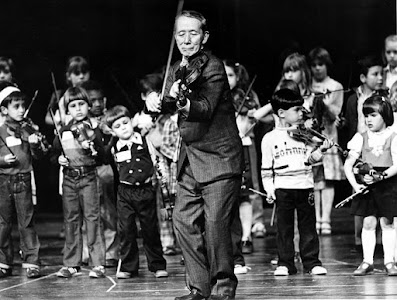The Suzuki Method was invented by Dr. Shinichi Suzuki. It is designed to enable children to begin successfully learning a musical instrument from a very young age. Dr. Suzuki was inspired to create this method when he realized that children can learn music the same way they learn a language (in fact, he originally called his method the "mother-tongue approach"). By immersing children in music through listening, strong parental involvement, and delayed reading, the Suzuki Method allows children to absorb music they are learning much like they pick up their native language.
Dr Suzuki in action |
Start at a Young Age
Why start a violin or viola student at a young age? The best answer is "why not?"! Young children pick things up quickly and intuitively, so starting to learn an instrument younger puts them at a definite advantage. The Suzuki Method is unique in that it can effectively be started at a very young age (while more traditional methods of teaching will be less effective unless started at an older age). That said, Suzuki is not just for very young children. In fact, it can be adapted to work with students of any age.
Learn by Listening
The Suzuki Method places great importance on listening to music as part of the learning process, and each Suzuki book has a CD with recordings of all the pieces your student will be learning. There are many reasons listening is so important. Younger children do not possess strong ability to read music, so listening will be their primary way of learning their music. Also, listening to recordings helps students of all ages to develop sensitivity to musicality and intonation. Hearing their music played by a professional musician provides students with a model for playing beautifully and accurately.
Delayed Reading
As mentioned above, young children do not yet possess the skills to read music at a high level. For this reason, Suzuki students would progress more slowly if their main method of learning was reading music. Children's ability to play by ear is initially far superior to their reading (Dr. Suzuki compared this to how children first learn to speak by listening and mimicking their parents, learning to read later).
This does not mean, however, that Suzuki students will not learn to read music. Reading is simply introduced at a developmentally appropriate time for each student, often on separate music from the Suzuki pieces.
Parental Involvement
The Suzuki Method requires a great deal of parental involvement in the learning process. This makes the method more effective and enjoyable for parents and child. There is generally a designated "Suzuki Parent" in the household, although both parents are encouraged to participate as much as possible. The Suzuki Parent will initially learn the basics of playing the instrument along with the student. The Suzuki Parent will be present at all lessons and make note of what is being taught. Younger children usually do not possess the motivation or attention span to practice without supervision, so the Suzuki parent will act as the "home teacher" and supervise practice to make sure things are practiced correctly (as taught at the lesson). Parental involvement is also motivational to the child, because they feel supported and learning becomes a family activity. Being a Suzuki Parent doesn't require any previous musical knowledge. The few things you need to know will be taught to you by your Suzuki teacher.
Consistent and Progressive Literature
All Suzuki students learn the same music in the same order. The pieces are placed in a logical order so that new concepts are constantly introduced, but there is enough familiar material that it is never overwhelming. Each new piece builds on the previous one. Students are encouraged to listen ahead on their CDs so they know and recognize the pieces they will be learning in the future, which can be very motivational.
Another excellent and unique feature of the Suzuki Method is the capacity for group learning, made possible largely because all the students know the same music. Students will frequently take part in group classes, workshops, and recitals where they can work on and perform their music with other students. In fact, a Suzuki student could attend a Suzuki workshop anywhere in the world and be able to participate with students at their same playing level.
Most Suzuki teachers also teach additional material aside from the Suzuki music. This can include anything from technique like scales and arpeggios to extra "just for fun" pieces. The Suzuki music is the main thread that distinguishes the method, but teachers are free to supplement with whatever additional music they feel will best benefit their students.


